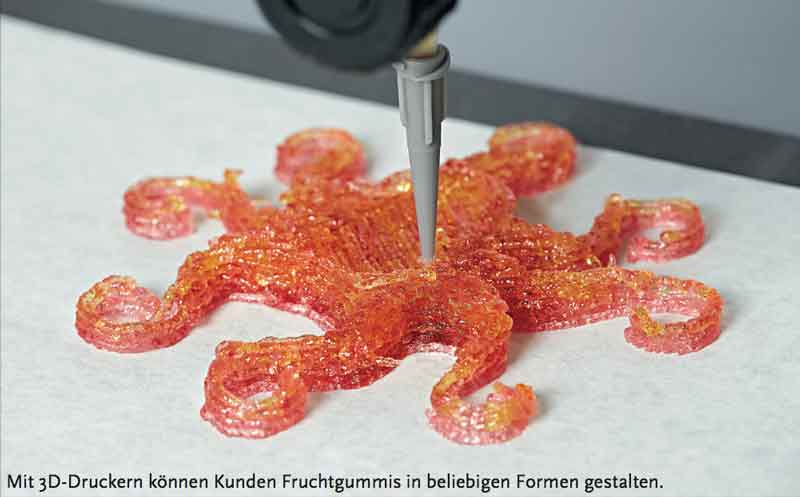Gummy bears from the 3D printer
![[shutterstock:383918755, Visual Generation]](https://e3mag.com/wp-content/uploads/2017/01/shutterstock_383918755.jpg)

If you look at the many studies on Industry 4.0, one thing becomes clear: The Internet of Things (IoT) is perceived as an idea driver.
In addition to start-ups, established manufacturers and branded companies in the food sector also want to participate in order to open up new markets.
The associated flexibilization or modularization of production to the smallest units requires maximum data availability - since ERP systems hold a large part of the data, they play a central role in IoT projects.
"Real-time optimization in the individualized manufacturing process also requires real-time data, and this is provided by ERP, among other things"Cormeta board member Holger Behrens points out.
The food industry is virtually forced to drive the digital transformation if it wants to open up new fields. I
ndustry 4.0 supports the expansion of a customer-specific business-to-consumer business.
Additive manufacturing
It's fascinating when you get a nine-course meal completely from the printer in a 3D restaurant or have your muesli and chocolate bar printed with your individual image.
The process in the first example is similar to injection molding or extrusion, only in a 3D printer with food-safe nozzles. The result is pizza, chocolate mousse or mashed potatoes.
In the second case, the packaging machines must be correspondingly modular and flexible, a challenge that the packaging industry is already quite capable of mastering, as practical examples show.
In addition, the topic of individual packaging in the seasonal and gift business is not all that new, just not in small series and up to batch size 1.
Holger Behrens, Cormeta Board of Directors:
"End users demand products tailored to them.
There are already some examples of customization here, such as Katjes Candy Factory with consumer 3D printing."
The fruit gum maker has set up 3D printers in some stores that can be used to create custom candy from numerous shapes.

Resourceful appliance makers are already thinking about combining 3D printing and baking ovens.
Automation is of course no stranger to the process manufacturing industry; many processes have already been automated and in some cases digitalized in recent years.
"We have already optimized many digital processes at our customers in the food industry with ERP implementation, and to a large extent we have also automated them with intelligent workflow support."
Behrens explains.
However, the focus of the digitized processes was always the ERP system, at Cormeta the SAP all-in-one industry solution Foodsprint.
"Certainly not all customers have implemented PLM functionality or automated QM processes and system-supported recipe development, but documentation, batch traceability and in-process controls for HACCP or FDA have now been implemented by most."
But especially in the run-up to digitization, it is important, for example, to use software to support recipe development and quality assurance in order to bring innovative food products to market quickly.
"What good is a great development department with good ideas if they have become obsolete by the time they are launched on the market?"
says Behrens.
Especially against the backdrop of intensifying international competition, innovative products can open up new markets.
In addition to integrated formulation development, individualized production and transparency of material and process costs are essential prerequisites for rapid market development.
"For mid-sized food producers, these are real challenges"
knows Behrens,
"flexible and customized, ready-made production requires transparency across all processes, and this is where we can provide support."
The flexibility extends to label printing, which is triggered by data from the ERP system, and even to the individual single label, if required.
"We must never forget: Digitization requires digital data and there a large part comes from the master data of the ERP systems, from PLM, CRM, DMS, etc."
A PLM should be flexible enough to allow, for example, new recipes to be developed successively by modifying existing ones.
Here, functions such as mass change or simple copying of recipes are advantageous.
Work is made even easier if label data can be sent directly to marketing or the packaging manufacturer via a communication interface.
A status change ensures that the production bill of materials is automatically generated from a new recipe.
Food producers who introduce additive manufacturing processes will design their production to be flexible and modular.
A large bakery, for example, will not install an oversized 3D printer in its process plant for the production of dough pieces, but will set up a series of parallel, smaller process units.
These can be equipped more flexibly and changed over more quickly, which is enormously important for the smallest batch sizes.
So even the wholesale baker could make a customer's personal roll every day and deliver it to the store.
"These are no longer utopias, but will soon be a reality"
predicts Holger Behrens.
What is already possible today for cereal packaging will be possible tomorrow for many food products in the sense of business-to-customer.
A key issue here is transparency about processes, procurement, material flows, etc.
"Without end-to-end ERP software, there is hardly any transparency left with the rapidly changing production orders"
Behrens notes.
"Production status, material availability, equipment utilization, QM data and much more must be ready at the push of a button."
From batch tracking to food tracking
"Consumers today are considerably more sensitive than they were years ago about the origin of their food, they want to know where something was produced and where the raw materials for it came from"
knows the Cormeta mind.
That's why one of the technology-driven topics at Cormeta's ERP specialists recently has been food tracking.
To make it transparent where chips, pasta and schnitzel come from, proof of origin is required. Most IT solutions are also able to map this.
In the process industry, track and trace to the customer plays a decisive role today in addition to batch traceability in mass serialization.
Also increasingly relevant for the food industry and retail is that buyers expect more transparency.
The scandals of recent years have unsettled many consumers. The customer in the supermarket wants to know where the raw materials for a product come from, on which field the wheat for his toast was harvested or in which barn the pig for his schnitzel was fattened.
In a modern software solution for the process industry, all data on raw materials and their origin should be visible and traceable at all times.
For this purpose, it must be possible to record the batches of origin at goods receipt in different ways: either via data provided by the manufacturer or, optionally, by means of a goods receipt inspection of the supplier batches.
The software should then be able to automatically assign the goods receipts to the origin data.
For example, if pork is delivered from a slaughterhouse to a sausage producer, the sausage producer must also provide the information on the origin of the pigs.
This supplier batch must be able to be carried along throughout the entire production process.
By assigning a tracking code, the supplier batch can be virtually married to the production batch from the production order.
"We recommend printing the tracking code as a QR code on the packaging, for example, so that it can be tracked back to the original producer."
Behrens explains.
Such a function allows the origin to be clearly traced and tracked.
For example, meat and sausage producers using such a solution can use the QR code to provide all the information they need.
At the meat or sausage counter, the customer scans the code on the schnitzel, chicken or sausage package by cell phone and can, for example, use an online platform with the stored finished products to clearly determine the origin.
Cloud makes data mobile
Flexibility here also means the flexible connection, networking and control of modular process systems up to the 3D printer.
"Industry 4.0 is inconceivable here without mobility".
Holger Behrens emphasizes.
A comprehensive construction kit under the SAP Fiori platform is available for flexible app creation, and collaborative teamwork is supported by SAP Jam, an integrated social media communication platform.
"We need to ensure fast data availability, whether on-premise or from the cloud, whether on PCs or mobile devices via apps."
For this reason, Cormeta's ERP experts brought the Foodsprint industry solution onto SAP S/4 Hana and tested it intensively.
As a result, the team of consultants now has extensive expertise in migration support for S/4 Hana.
"It is important for us to combine our many years of process know-how within the food industry with comprehensive technology expertise."
clarifies Behrens.
"Before the industry processes are converted, we test them again intensively and accompany the customers on their way to digital transformation."
A dedicated technology team takes over the conversions to Hana or S/4 Hana and the support of SAP cloud as well as mobile solutions, detached from the actual ERP consulting.
Cormeta itself currently runs several Hana applications in-house for development and testing purposes.
If you want to be prepared for the digital age and Industry 4.0 as a medium-sized food producer, you cannot avoid end-to-end data and process support in order to ultimately pave the way to a globally competitive world through individualization and the greatest possible transparency.




